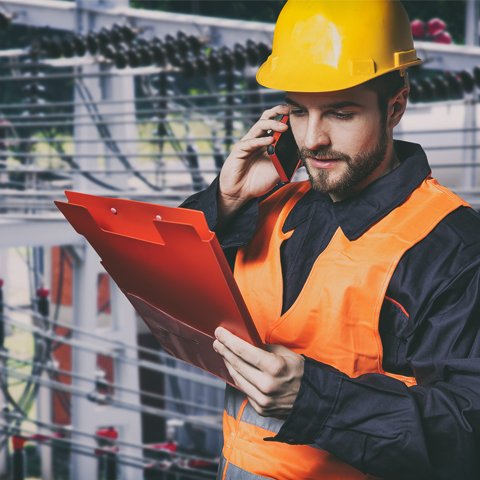
Private underground facilities are found everywhere, including single family homes, farms, multi-family housing units, businesses, industrial areas, trailer parks, shopping centers and sometimes in the road right of way. Gopher State One Call encourages owners and operators of private underground facilities to include those facilities on to the GSOC System. However, most private facilities are not listed on GSOC. Unless the private facility owner participates in GSOC, privately or customer owned facilities will not be notified and may not be marked. Therefore, it is imperative that special precautions be taken by excavators as part of every excavation project.
GSOC recommends every excavator make a detailed inquiry for private facilities as part of every excavation project. This inquiry can include physically inspecting the entire construction site and the surrounding area or interviewing owners or occupants (or former owners or operators). Ask questions! If a building has heat, what is the source of supply? If there are lights, there is electricity.
Please read the following to get a better understanding of private underground facilities in your excavation area.
What are private electric underground facilities?
Private underground facilities, or customer-owned facilities, are those facilities that were installed behind or after the meter. Also, if overhead distribution lines serve the property and the power is then distributed on the property by underground service facilities, those service facilities may be considered private. If the homeowner's electric meter is located on the property line, then that electric line from the meter to the house is considered privately owned and will not be located.
Where are private facilities found?
Private facilities are found everywhere, including single family homes, multi-family housing units, industrial areas, trailer parks, shopping centers and sometimes in the road right of way. Other private facilities can include: natural gas farm taps, natural gas or propane gas underground piping to buildings, gas grills and pool heaters, private water systems, data communication lines, underground sprinkler systems, invisible fences and many others. Unless the property owner participates as a registered facility operator of Gopher State One Call, private or customer-owned facilities will not be marked or notified. If you have a question on whether a facility in your excavation area is considered private or not, please contact that local utility office.
Whose responsibility is it to locate private facilities?
When a property owner or tenant has any type of private underground facility, they are responsible to locate those facilities, or hire someone to locate them. Please visit Gopher State One Call's Industry Directory for a list of private locators in your area. Remember that these locators will locate the lines for a fee. This list is by no means an exhaustive list or a list of locators recommended by GSOC. For additional locators, consult a search engine, like Google, or the Yellow Pages under "Utilities Underground - Locating."
If I am an excavator, how do I educate the homeowner about private facilities?
The homeowner may not be aware that these facilities will go un-located if they just phone in a locate request to GSOC. As the excavator, it is necessary to be aware of the work site. Where is the meter box? Is there a propane storage tank? This can be aboveground or underground with underground supply piping to the building. Is there a detached garage or outbuilding with lighting? Is there a pool heater or gas grill? How about underground sprinkling system or underground wires to keep the family pet within the property? Also remember that previous property owners may have installed lines. Take a few minutes and review these items with the homeowner prior to beginning excavation. If you have additional questions about private facilities, please email your questions to our Customer Support.
Private facilities can be used to convey many different types of products. These products fall into two broad categories: energy related facilities and non-energy related.
Energy Related Facilities
Energy related facilities include natural gas, electricity, and propane. These lines or pipes can provide service for a variety of different purposes.
Propane

Propane facilities can be found in a variety of applications in residential, agricultural and industrial settings. In residential settings, propane may be used to heat buildings, swimming pools, grills, fireplaces and appliances. Propane may also fuel lighting and other appliances. In agricultural settings, propane may be a fuel source for buildings, corn dryers and other equipment.Commercial and industrial locations also rely on propane for a fuel source. This can include a wide variety of facilities from heating to standby or off-peak backup facilities.
Visible indications of the use of propane at a location are above-ground or buried storage tanks. A buried propane tank usually has an exposed location with a fitting for re-filling. Remember that a single propane tank can provide fuel for multiple buildings, trailer homes, single family homes, cabins or town homes.
For more information about propane, please visit the Minnesota Propane Association’s web site at www.mnpropane.org.
Natural Gas

Private natural gas lines in a residential setting may provide fuel for a number of different devices. Among them are barbecues and grills, pool heaters, yard lights or heaters in outbuildings like sheds, garages or barns.Natural gas may be delivered to a “master meter” at multi-resident properties, such as trailer parks, town home or apartment complexes. Buried facilities conveying natural gas between the master meter and units on the property are usually private facilities. As a general rule, natural gas providers will only mark underground gas lines from the main to the meter. It is important to remember the operators of natural gas facilities only mark the line leading to the meter. Any appliance or device fueled by natural gas that is on the “other side” of the meter is almost invariably served by a private facility.
For more information about natural gas, please visit the Blue Flame Association’s web site at www.blueflame.org.
Electricity

Like natural gas, electric service may be supplied to a “master meter” at multi-resident properties, such as trailer parks, town homes or apartment complexes. Any line that connects the “master meter” to another unit or device on that property is private.
Residential properties may also have buried private electric lines that serve to power among other things, yard lighting, pool heaters or pumps. Additionally, on residential properties or farms, private lines may connect outbuildings like garages, sheds, barns or electric fences to a source of power. Remember that the supplier of electricity usually only marks the power line up to the meter. If there is power source in a garage or if a piece of equipment or building is served by electricity, make sure to look for a private electric line.
Although the meter set is often found on/at the home or main building, in some areas it is set on a pole or other attachment at a nearby power line. Red marks or flags leading up to a pole but not going on to each of the other buildings are indicators that there is one or more private facilities in the area. Also, use care where a property is served by overhead lines, that are buried after they enter the property. In this situation, it may be that all underground electric facilities are considered private.
Other Types of Private Facilities

Several other types of private buried lines may be found on private property. Some may carry low-voltage electrical current. These include buried lines for invisible dog fences, data communications cables, and low voltage landscape lighting. Other private facilities can include water systems, septic systems, underground sprinkler systems and private phone lines that connect outbuildings to a home or waste collection lines. Drain tile, irrigation and other facilities may be found in rural areas. Between industrial or commercial building connections, steam lines, private communications or fiber lines, tunnels and a variety of facilities may exist.
Be On the Lookout for Private Facilities
A good excavator is also a great detective or investigator. The excavator knows that private facilities will be part of almost every job. They physically inspect the jobsite prior to entering a ticket (or even bidding the job), they query the property owner, see what equipment or power may serve buildings they will excavate around, and look for warning signs. They find out who installed the original underground facilities and contact them to determine if any records or maps exist. They also prepare maps of any new facilities they install, so that this problem doesn’t exist in the future.
What Should I do if I Suspect I Have Private Facilities in the Area of My Excavation?
Do not dig until they are each identified and marked! When a property owner or tenant has any type of private underground facility, they are responsible to locate those facilities, or hire someone to locate them. The contact information for a number of private locating companies can be found in Gopher State One Call's Industry Directory.











